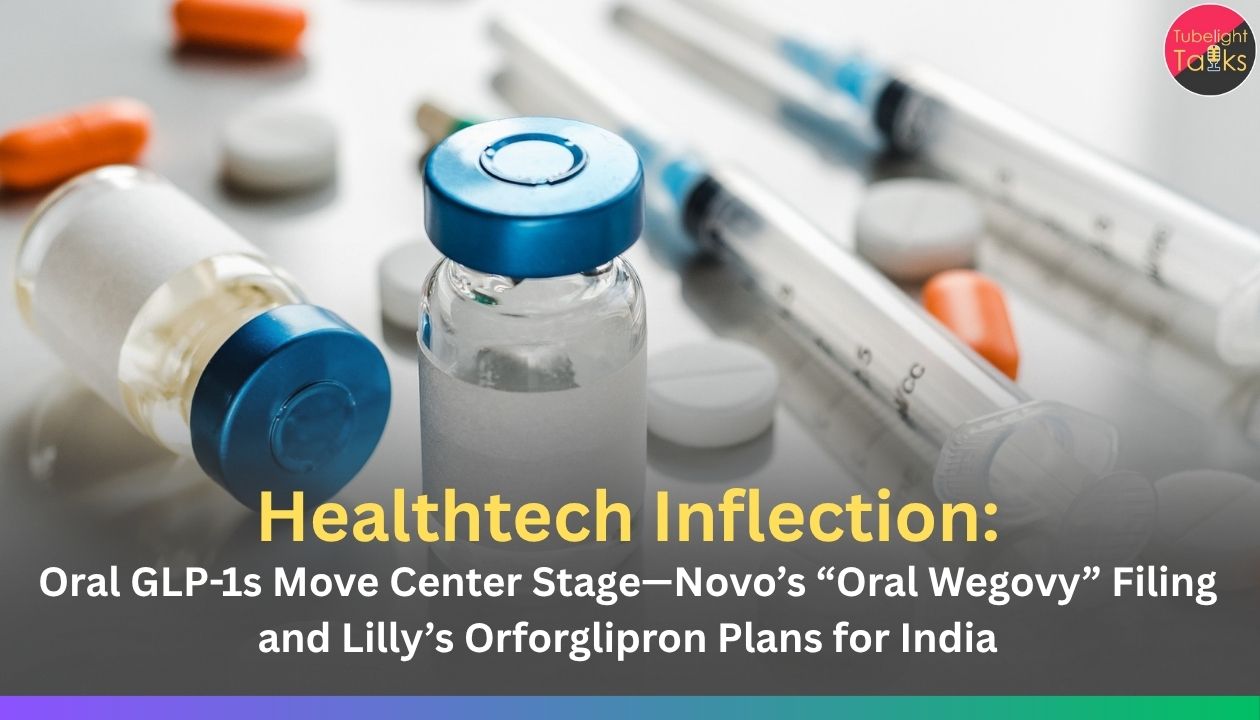Healthtech Inflection: Oral GLP-1s just crossed a threshold. Novo Nordisk has submitted oral semaglutide 25 mg for FDA review as a pill formulation of Wegovy, backed by OASIS-4 data showing ~16–17% weight loss and improvements in cardiovascular risk factors; fresh analyses landed at ObesityWeek 2025. Eli Lilly meanwhile confirms plans to bring its oral GLP-1 orforglipron to India, after Phase-3 readouts in obesity and type-2 diabetes. The pivot from injections to pills could expand access—if regulators, payers and supply chains are persuaded on safety, labeling, price, and manufacturing. Here’s the state of play and the scrutiny to expect through 2026.
What’s new (and official)
Novo’s “oral Wegovy” filing and data drop
- FDA filing accepted for oral semaglutide 25 mg—positioned as “Wegovy in a pill” for chronic weight management. A company brief cites OASIS-4 (NEJM) with 16.6% mean loss at 64 weeks and CV risk-factor gains; ObesityWeek 2025 added new analyses. (Product not yet approved.)
Lilly’s orforglipron—Phase-3 and India
- Phase-3 program completed key trials; conference reports show weight, A1c and risk-factor improvements. Lilly India says it plans to launch orforglipron in India pending approvals, putting the country in the early wave of submissions.
Why oral GLP-1s matter
- Preference & reach: Many patients prefer pills to injections, potentially improving initiation and adherence—critical for chronic management.
- System impact: If priced accessibly, pills can move treatment earlier in the care pathway, with knock-ons for cardiometabolic risk. (CV signals featured in both programs’ updates.)
What regulators will scrutinise (US/EU/India lens)
Labeling & safety
- Class warnings (thyroid C-cell tumours/MEN2), GI events, pancreatitis/gallbladder signals, and pregnancy contraindications will shape labels and REMS-like requirements. (See Wegovy US label context; oral version not approved.)
Cardiovascular read-across
- Regulators will ask how CV benefit/risk from injectable semaglutide maps to the oral formulation and whether outcomes data are needed post-approval. New ObesityWeek analyses of CV risk factors will be weighed, but hard outcomes remain gold-standard.
Dose-titration & adherence
- GI tolerability drives discontinuation. Expect emphasis on titration schedules, missed-dose rules, and drug–drug interactions (esp. with oral agents in diabetes).
India specifics (CDSCO/DCGI)
- Bridging data, post-marketing surveillance and pharmacovigilance plans; scrutiny of promotion to prevent cosmetic/off-label use. NPPA could examine price controls or negotiated pricing given chronic use.
What payers will probe
1) Total cost of care
- Pricing vs injectables; impact on hospitalisations, sleep apnoea, NAFLD/NASH, and CV events—payers will ask for budget-impact models.
2) Real-world persistence
- Do pills improve 6–12-month persistence? Step-therapy and prior auth likely hinge on discontinuation rates vs weekly injectables.
3) Supply integrity
- Both classes have faced shortages; payers may seek supply guarantees, caps on compounding channels, and anti-diversion controls.
4) Appropriate use
- Guardrails to restrict use to qualifying BMI/comorbidity criteria and to manage pregnancy planning and pediatric extensions.
Market signals to watch (2025–26)
- FDA action on oral semaglutide 25 mg and any post-marketing commitments.
- Lilly submissions timeline in India and other early-wave markets for orforglipron.
- Pricing disclosures and any NPPA engagement in India.
- Head-to-head or network meta-analyses comparing oral agents vs injectables on weight, CV markers, adherence.
Care Before the Hype
Taking a cue from Sant Rampal Ji Maharaj’s emphasis on value based system: declare scorecards (discontinuation, GI AEs, pregnancy exposures), commit to independent safety audits, and ring-fence affordable access for public hospitals and state programs. That’s how an oral GLP-1 wave becomes responsible access, not just a market boom.
Pills can widen access, but proof must travel from podium to policy
If oral Wegovy wins approval and orforglipron moves into India’s review queue, the case will turn on transparent safety labels, sustained supply, and prices that unlock payer coverage. Add real-world persistence data and credible CV outcomes signals, and oral GLP-1s could shift obesity care beyond specialty clinics into primary care—where India’s need is largest. Until then, the watchwords are data, discipline, and equitable design.
Read Also: The Growing Obesity Epidemic: India’s Challenge by 2050
FAQs: Healthtech Inflection – Oral GLP-1 moment
1) Has “oral Wegovy” been approved yet?
No. Novo’s oral semaglutide 25 mg has been filed with the FDA; it’s not yet approved for weight management. New analyses were presented at ObesityWeek 2025.
2) What’s the latest on Lilly’s orforglipron for India?
Lilly says it plans to launch orforglipron in India pending approvals, following Phase-3 readouts; India is in the first wave of submissions.
3) Why would payers treat pills differently from injectables?
They’ll reassess adherence, cost, and supply stability—pills may improve uptake but must show real-world persistence and budget benefits to win broad coverage.
4) What safety points will be front-and-center on labels?
GI AEs, pancreatitis/gallbladder warnings, thyroid C-cell/MEN2 class warning, pregnancy guidance, and dose-titration instructions—aligned with the GLP-1 class. (See Wegovy label context.)
5) Could India cap prices?
Not guaranteed, but NPPA has authority over pricing frameworks and often scrutinises chronic-use therapies; CDSCO will drive approvals and pharmacovigilance.










